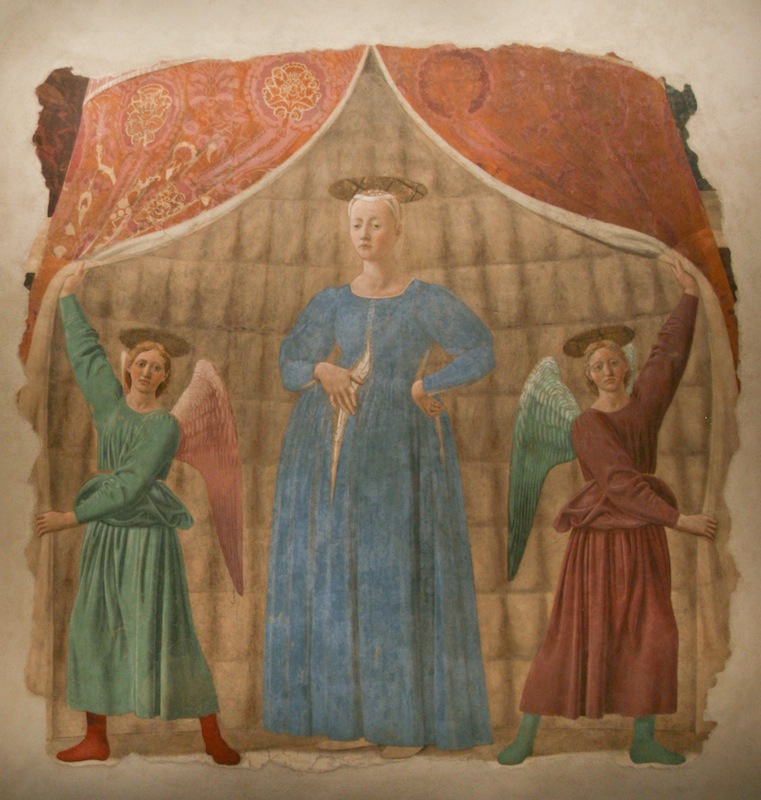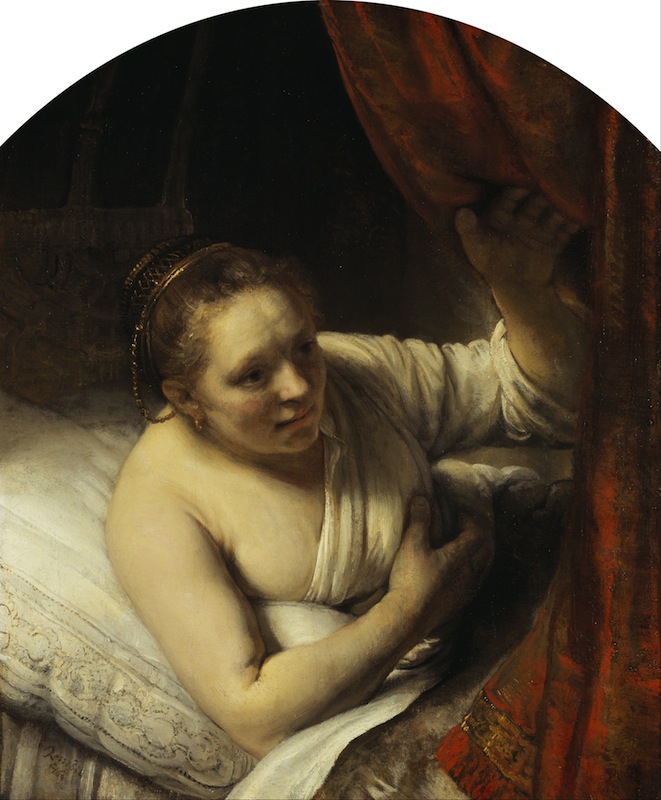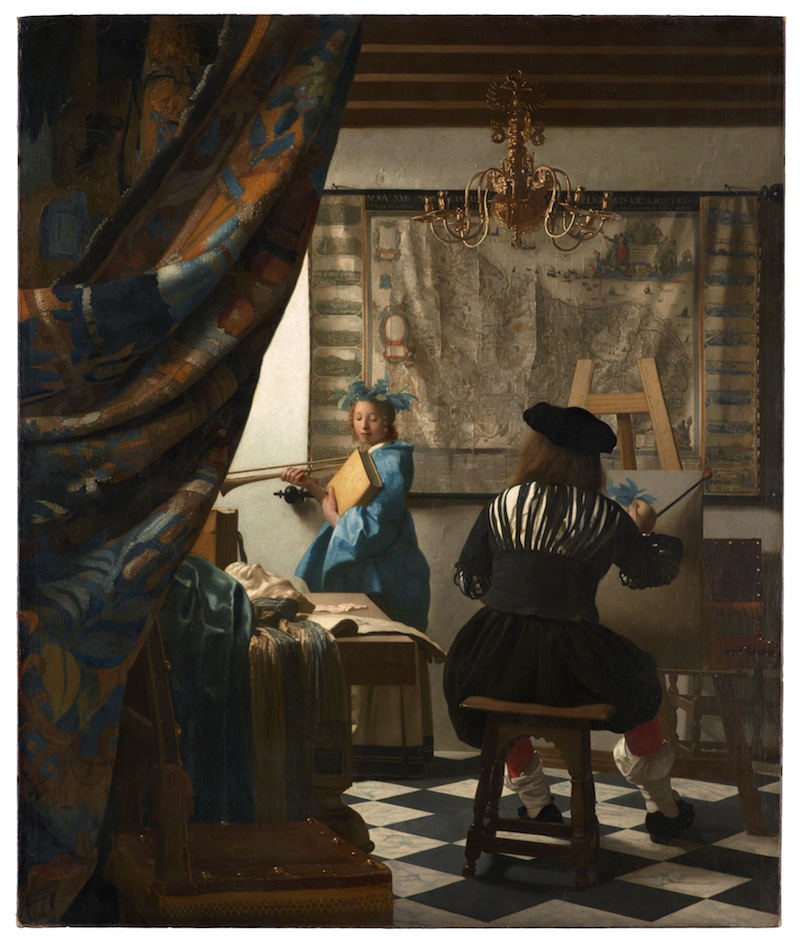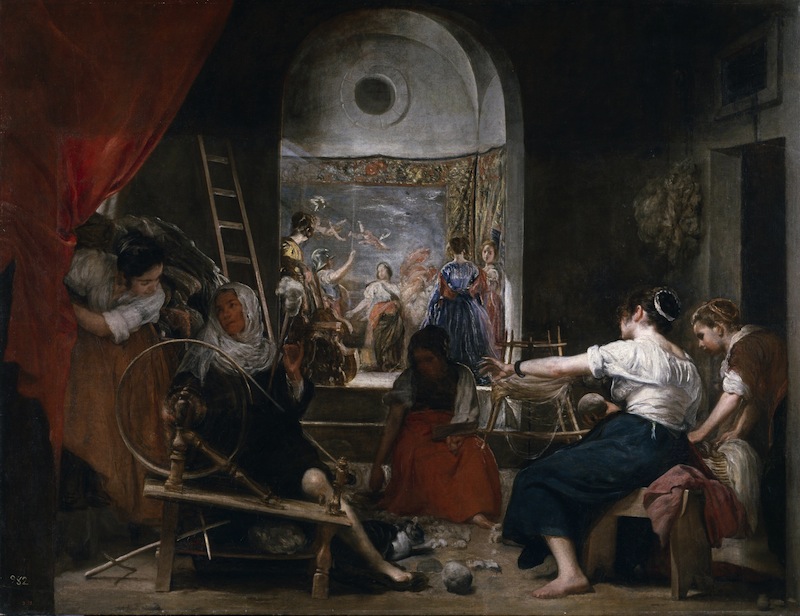Why paint a curtain? The motif of draping an image in cloth reaches back to antiquity, revealing preoccupations with artistic competition, hidden meanings, and the limits of realism
In his Historia naturalis, Pliny the Elder tells the story of a competition between the artists Zeuxis and Parrhasius. Zeuxis painted a bunch of grapes so lusciously real that birds flew down to peck at the painting. Confident of his success, Zeuxis asked Parrhasius to draw back the curtain covering his work, only to realise that the curtain itself was the painting and that Parrhasius had won the competition. On its surface, the tale suggests that verisimilitude and trompe l’œil are the true tests of art. But as Zeuxis said in acknowledging defeat, to fool your fellow artists is better than to fool the birds. Parrhasius relied not just on technique, but on manipulation of expectation, to hoodwink Zeuxis.
Their competition, and its reflection on realism and convention, is reprised on a single canvas in Trompe-l’Oeil Still Life with a Flower Garland and a Curtain (1658), now hanging in the Art Institute of Chicago. A still life of blooming and overblown flowers with insects by Adriaen van der Spelt is partially concealed by a blue silk curtain, painted by Frans van Mieris. Seventeenth-century paintings were commonly kept in domestic interiors behind such coverings, and the image plays on the theatricality of unveiling involved in such display of art. However the trompe l’œil goes further than a joke to invoke the questions of realism and illusion proposed by Pliny’s tale. Van der Spelt’s still life is a fine example of the genre, with its carefully observed natural detail and exquisite rendering of the texture of petals and butterfly wings. In comparison with van Mieris’s mastery of light and illusionistic technique, however, it looks conventional and flat: more still than life. The background shows, dimly, a vaulted room or alcove, but van Mieris’s hyperrealism trumps that trompe-l’œildepth.

‘Madonna del Parto’ (c. 1455–65), Piero della Francesca (c. 1415/20–92). Museo della Madonna del parto, Monterchi
Again, it is not just van Mieris’s skill that bests van der Spelt. His curtain seems ‘real’ not just because of its rendering, but because it is a curtain, and seems to belong to the world of the viewer and not that of art. Leon Battista Alberti, in his De pictura (1435), famously recommended that a painting be conceived as an open window through which its subject – thehistoria – might be seen. To paint a curtain is to interpose something between the viewer and the historia. It is not fully part of the picture; instead it is an invitation both to examine critically the painting’s apparentsubject – often, paradoxically, by covering part of it – and to reflect on the claims and limits of realism and representation. A curtain is not supposed to be looked at; the viewer’s instinct is instead, like Zeuxis, to ask what lies beneath.
‘To draw a curtain’ can mean two apparently contradictory things: to pull it aside to reveal what it had concealed, and to pull it in front of an object, in order to hide it. To draw – and to paint – a curtain is thus both to cover and discover. Such dynamics of concealment and revelation have particular resonance in devotional imagery, and the paradox is especially potent in Piero della Francesca’s great fresco, the Madonna del Parto (now in the Museo della Madonna del Parto, Monterchi; c. 1455–65). The pregnant Madonna stands revealed by symmetrical angels who have drawn back the curtains of a canopy. This discovering is echoed in the Virgin’s own parting of her garments over the bulge of her pregnancy. Though this displays nothing but more fabric, her gesture refers both to her imminent childbirth – the parting of parturition that gives the fresco its title and purpose, as an object for the devotion of pregnant women – and to the mystery of the Incarnation, the divine in human form, in the baby she carries.

‘Trompe-l’Oeil Still Life with a Flower Garland and a Curtain’, 1658, Adriaen van der Spelt (1630–81). Art Institute of Chicago
As the canopy contains and reveals Mary, so she contains and reveals the infant Jesus. Moreover, the details of the canopy recall the Old Testament tabernacle, described in Exodus as made from 10 curtains, coloured purple and scarlet with trimmings in gold, and lined, as here, with animal skin. The tabernacle creates a curtained zone of sanctity, the Holy of Holies, housing the divine presence, and barred to trespass by any but the High Priest. In the typological interpretation which sees the Old Testament as foreshadowing the gospels, the tabernacle prefigures Mary. The angelic opening of the curtains in Piero’s fresco thus symbolises the fulfilment of the Old Testament in the New, and the new accessibility of the divine in human form. Interpretation pulls back the curtain of allegory. In the Incarnation, the divinity of Jesus is veiled in flesh; not, however, in the sense that the divine is concealed by body, but in that its mystery can only be made manifest through it. The curtain is at once what must be withdrawn to see the truth; and what must be looked at to reveal it.

‘A Woman in Bed’, c. 1645–46, Rembrandt van Rijn (1606–69). Scottish n National Gallery, Edinburgh
In Rembrandt’s A Woman in Bed (c. 1645–46), now in the Scottish National Gallery, the themes of curtain and flesh, revelation and concealment, are also at play, although – at first sight – this is a paintingmuch more concerned with secular senses of the uncovering of bodies. It depicts the intimate space of a curtained bed. The richly embroidered drape is pulled back by a woman from within that enclosure. This partial revelation is repeated more subtly in the other cloths that cover her: she is lying under a blanket, but the cant of her lean takes her partly out of it; she is wearing a nightshirt, but only over one shoulder: most of her right breast is exposed. Each material half conceals and half reveals her. In this sequence of layers of fabrics, closer and closer to her flesh, her skin itself becomes a kind of cloth. The visible folds of her armpit, elbow, and furrowed forehead encourage the comparison.
The layered coverings mark boundaries between publicity and privacy. The painting toys with intimacy, and the barriers that must be crossed to enter into it. The woman’s expectant stare encourages us to assume a lover. Some scholars have suggested a specific scenario. GivenRembrandt’s repeated recourse to the Book of Tobit as a source, and the painting’s similarities with a work by his master Pieter Lastman, A Woman in Bed has been identified with the wedding night of Tobias and Sarah. In this tale, Tobias is Sarah’s eighth husband; the previous seven had all been killed on their wedding night by a demon. The price they paid for attempting to cross into the zone of intimacy of the curtained bed was death. Tobias, however, protected by the angel Raphael, is able to drive out the demon and consummate their marriage.
There are few clues in the painting that would confirm this disputed association: no demon, no Tobias, no angel. But accepting it enriches the symbolism of the curtain. The status of the Book of Tobit was problematicin the 17th century; though canonical in the Roman Catholic Bible, Protestant theologians denied it was a book of divine revelation, and consigned it instead to the Apocrypha. The Dutch Bible established in 1618 prints Tobit, but, as Julius Held has indicated, with a prefatory warning that it is untrustworthy, because of the fantastical tale of the expulsion of the demon and the death of the seven bridegrooms. If this is a depiction of the wedding night of Tobias and Sarah, it is precisely this most dubious moment that Rembrandt chooses as subject. The disputedstatus of the Book of Tobit is thus encoded in the painting itself. ‘Apocrypha’ means, literally, ‘hidden, covered up’. The themes of revelation and concealment, visible in the curtain and fabrics, are also the condition of the painting’s historia.

‘The Art of Painting’, c. 1666–68, Johannes Vermeer (1632–75). Kunsthistorisches Museum, Vienna
In both Piero and Rembrandt, a painted curtain invites reflection on the relationship between the seen and the unseen, and the immanence of allegory or revelation in the mundane and material. This may seem very distant from the competitive tests of skill in Zeuxis and Parrhasius, or van der Spelt and van Mieris. What they have in common is the positioning of a curtain at the forefront, to lead the viewer to consider what painting can reveal or conceal. Other examples combine competitive painterly mastery with the issues of interpretation evident in Piero and Rembrandt. The Art of Painting (c. 1666–68), for example, is at once a bravura exhibition ofVermeer’s skills of naturalism, illusionism, and perspective, and a complex allegory of the claims of painting to supremacy in the arts.
Vermeer symbolically incorporates music, sculpture, history, poetry, and cartography, to demonstrate painting’s surpassing of them all. In this, the curtain that covers about a quarter of the canvas acts variously as an exhibition of illusionistic skill, a theatrical gesture of invitation into the scene of the painter’s art, and a signal of allegory, of the fact that something is to be discovered in the image beyond its demonstration of mastery.

‘The Spinners’, 1655–60 (with alterations after fire damage in 1734), Diego Velazquez (1599–1660). Museo Nacional del Prado, Madrid
The same is true of Velázquez’s The Spinners (1655–60). The background represents a scene from the myth of Arachne in Ovid’s Metamorphoses – the moment when Athena, angered at having been bested by Arachne’s human craft in a weaving contest, strikes her with a shuttle before turning her into a spider. The myth confronts art as divinity with art as human exercise of skill. The canvas as a whole makes the same juxtaposition.Classical myth is staged in the alcove in the background, while human labour dominates the foreground, where five women are involved in the business of making wool: winding, spinning, carding, skeining – and one withdrawing a red curtain, which might otherwise obscure our view. Their activity stresses the material ground of historia: storytelling as weaving, or the woven canvas behind the painted image. This is underscored by the tapestry hung at the back of the alcove, which is at once Arachne’s contribution to the contest, and Titian’s Rape of Europa rendered in thread. Like Parrhasius, van Mieris, and Vermeer, Velázquez thus stages an artistic competition – between inspiration and craft, myth and realism, Athena and Arachne, Titian and Velázquez himself. Taken as a whole, The Spinners exhibits both poles of these confrontations. And again, the viewer’s encounter with these knotted problems is mediated by thewithdrawal of a curtain: the product of the human art of spinning, and a gesture of display.
Each of these painted curtains relies on its ambivalent role: both part of the painting
and a framing device, at once involved in the historia and a commentary on it. Their significance relies precisely on their not being
the main subject of the painting. A final example, however, mimics Parrhasius’s gesture precisely. In the mid 1960s, Gerhard Richter painted a series of paintings entitled
Vorhänge: curtains. In these works, the curtain doesn’t signal or manage a
boundary between different kinds of depiction: it is what is depicted. If, as Alberti suggested, a painting is a window on historia, the view from the window is here emphatically blocked off.
To paint a curtain is in some sense to paint nothing. Or at least so Richter hoped. In the early 1960s, Richter practised black and white photorealism, an approach he justified as having ‘nothing to do with art’, in which banal and given subjects offered ‘a kind of escape’ from significance and interpretation. Though stylistically similar in combining illusionistic precision with the effects of blur, the curtains were not however based on photographs. By 1972, Richter wrote that they disappointed him; the deliberate nature of their composition betrayed his desired neutrality. Inevitably, given their history as mechanisms of conceal-ment and revelation, of critical stance towards historia, painted curtains offered not an escape from conventions of painting and interpretation, but a prompt to consider them.
Richter’s curtain paintings represent a realism so real, so exact, that it ceases to be recognisable as such. They flirt with abstract
ion. The oscillations of their folds, the rhythmic alternation of bands of blacker andwhiter grey, recall the op art paintings of Bridget Riley from the same period. The similarity is disrupted, however, by the scant
few centimetres of darker painting at the bottom of most of these canvases, which indicate depth, a floor. A study of form in two dimensions becomes the illusion of three.
In an interview in 1986, Richter remembered that, on coming across the avant-garde painting of Pollock and
Fontana as a student, he had been struck by their ‘shamelessness’. A curtain, however, represents at once shame and innocence, reticence and an invitation to prurient speculation. The drawn back curtain in Piero and Rembrandt was an invitation to look, an exposure of flesh, of the matter of bodies and what they might mean. In Velázquez and Vermeer, curtains acted as
a membrane between reality and myth or allegory. But in those paintings, there was a painted subject other than the curtain, about
which the curtain invited critical reflection. In Richter, there is nothing but the curtain. The German ‘Vorhang’, however, means literally something that hangs before; it invites specu
lation on what might lie behind it.
There are some obvious possibilities. Richter, born in 1932 in what became East Germany, emigrated to the West in 1961. These paintings, executed only a few years later, seem to invoke the Iron Curtain, the separation of
Europe into halves, adjacent and yet concealed and sealed from one another, especially since the erection of the Berlin Wall in the year of
Richter’s emigration. Or is there rather a suggestion of shame: of the failure of West Germany at that time to acknowledge the guilt of the era of National Socialism adequately, a curtain behind which the gruesomeness of unacknowledged crime is concealed? (Student protests and the terrorist activities of the Rote
Armee Fraktion would attempt to wrench back that curtain in the later 1960s and early 1970s; in 1988, Richter controversially returned to his photorealist style in the
cycle 18. Oktober 1977, which depicted the protagonists of the
RAF.) Or are we supposed to think of the history of art, the kind of curtains depicted by Parrhasius, van Mieris, Piero, Rembrandt,
Velázquez and Vermeer, a historical competition into which Richter here enters himself?
All of these, of course; and none. There is no way of settling these questions. Richter, as matador, holds out the grey curtain as a red rag to speculation, only to whip it away. In the
same period, Richter made various other attempts to short-circuit interpretation, including over-painting his own work. His 4 Glasscheiben (4 Panes of Glass; 1967) takes direct aim at Alberti’s notion of the painting as window by offering windows with no paint. The curtains series makes a similar gesture.
The painting-as-window, with all its art- historical baggage, is occluded by thecurtain-as-painting. But rather than securing meaninglessness and neutrality for the image, as Richter wished,
the curtain is the promise of meaning concealed. The gap at its bottom edge
lets interpretation in. As in Parrhasius’s winning composition, the painting of a curtain provokes the viewer to want to draw it back.
Kathryn Murphy is a fellow in English literature at Oriel College, Oxford.





